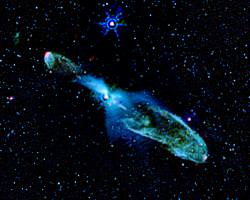A new image released from NASA’s Spitzer Space Telescope shows a baby star blowing bubbles, just like, I guess, a kid with bubblegum. But let’s see your kid hurl out material hundreds of kilometres a second across light-years of space. Those are some big bubbles.
The infant star is known as HH 46/47, and it’s located about 1,140 light-years from Earth. The star itself is that bright white spot at the middle of the image.
Surrounding the star are two bubbles of material extending out in opposite directions. These bubbles are formed when powerful jets of gas collide with the cloud of gas and dust surrounding the star. The red specks at each end signify hot sulfur and iron gas, where the jets are colliding head on into the gas and dust material.
Astronomers think that young stars accumulate material by gravitationally pulling in gas and dust. This process ends when the star gets large enough to create these jets. Any further material is just blown away into space.
Producing this image was a bit of a technical achievement. The researchers at NASA’s JPL developed an advanced image-processing technique for Spitzer data called Hi-Res deconvolution. The process reduces blurring, and makes the image sharper and clearer. With this technique, astronomers were able to make out the details of HH 46/47, and its surrounding bubbles.
Original Source: NASA/JPL News Release

